There are about 85 million dogs in America, and more homes are getting a furry friend every year. Dogs bring joy but also add risk to our homes. If your dog bites someone, you might be legally responsible. Knowing what your homeowners insurance covers is key.
Every year, millions of dog bites happen, often to kids. These bites can lead to big medical bills. In severe cases, a dog bite claim could reach hundreds of thousands of dollars. In 2022, the average cost of a dog bite claim was about $64,555, with 17,597 claims filed.
Key Takeaways
- Certain dog breeds are considered higher-risk by insurance companies, leading to potential coverage restrictions or increased premiums.
- The average cost per dog-related insurance claim increased by 31.7% in 2022 to $64,555.
- Some states, like Pennsylvania and Michigan, prohibit insurance companies from denying or canceling coverage based solely on dog breed.
- Responsible pet ownership, including obedience training, can help homeowners with high-risk breeds secure more favorable insurance terms.
- Understanding your state’s specific laws and insurance company policies regarding dog breeds is crucial when choosing a pet and maintaining homeowners insurance coverage.
Introduction: The Often-Overlooked Link Between Pets and Insurance
Many people don’t realize how their pets can impact their homeowners insurance. Homeowners insurance policies aim to protect you from unexpected costs. But, the type of dog you have can change how much you pay.
Liability coverage helps you if you’re liable for injuries or damage to others. It covers you if someone gets bitten by your dog on your property or elsewhere. But, not all dogs are covered. If your dog is on a list of restricted breeds, your claim might not be accepted.
It’s important to read your insurance policy to see if your dog is covered. Some insurers have lists of “aggressive” or “dangerous” dog breeds. They might not cover these dogs or charge more for them. Knowing this can help you choose the right dog for your family.
“Knowing the potential impact of your dog on your homeowners insurance can help you avoid unpleasant surprises down the line.”
Understanding the link between pets and insurance can protect your family, home, and wallet. Next, we’ll explore which dog breeds affect insurance, why, and how to get the right coverage.
Dog Breeds Facing Home Insurance Restrictions
Some dog breeds can affect your homeowners insurance. Insurance companies see certain breeds as more risky. This can lead to higher premiums or even no coverage. They worry about dog bites and the severity of injuries from big, strong dogs.
Pit Bull
Pit Bulls are often not allowed in insurance policies. They are linked to aggression and have been in many dog bite cases. So, Pit Bull owners might struggle to get affordable insurance or might need extra liability insurance.
German Shepherd
German Shepherds are also on the list of restricted breeds. They are smart and often work as service or police dogs. But, they can be strong and sometimes aggressive. This makes them a target for breed restrictions or higher insurance costs.
Great Dane
Great Danes are big and strong, but they’re also friendly and loving. Yet, their size worries insurance companies. They think a Great Dane bite could cause serious injuries. So, Great Dane owners might face extra insurance requirements or exclusions.
Siberian Husky
Siberian Huskies are known for their looks and lively nature. But, they’re often on insurance lists of restricted breeds. Their size and chase instinct worry some insurers. This can lead to higher premiums or even no coverage for Husky owners.
Staffordshire Terrier
The Staffordshire Terrier, including the American Staffordshire Terrier, is often linked with Pit Bulls. They have a muscular build and a history of dog fighting. This has made them seem dangerous to insurers, leading to restrictions or higher rates.
Remember, not all insurers treat these breeds the same way. Homeowners should look into their insurance options and talk with their providers. This will help them understand what’s needed and how it might affect their coverage.

“Certain dog breeds may be excluded from homeowners insurance coverage or face higher premiums due to their perceived risk of aggression and the potential for more severe injuries in the event of a bite.”
Homeowners Insurance Premiums and Dog Breeds
The type of dog you have can affect your homeowners insurance costs. Dog bites lead to high medical bills and settlements, making some breeds more risky in the eyes of insurers. In 2021, the average cost for dog bite claims was $49,025, according to the Triple-I.
Insurance companies might raise your premiums or deny coverage if your dog bites someone. This is because they want to lower their risk.
Some dog breeds face insurance restrictions because they are seen as high-risk or aggressive. These include:
- Pit Bull
- German Shepherd
- Great Dane
- Siberian Husky
- Staffordshire Terrier
Other breeds like Doberman Pinschers, Rottweilers, and Chow Chows are often banned or have exclusions. This is because they are seen as more likely to bite. Owners of these breeds might pay more for insurance or could be denied coverage.
“Approximately 85 million dogs live in the U.S., and about 4.5 million people, mostly children, are bitten by dogs each year in the U.S.”
Homeowners should check their insurance’s dog breed restrictions. They should also be ready to share info about their pet’s breed, nature, and any training. Knowing how dog breeds affect insurance can help homeowners make better choices and keep their coverage.
State-Specific Requirements for Dog Ownership
Homeowners insurance and dog breed rules change a lot from state to state. Some states stop insurance companies from using a dog’s breed to make decisions. It’s key for homeowners with dogs to know these rules.
In places like Pennsylvania and Michigan, insurers can’t deny or cancel coverage just because of a dog’s breed. These states aim to stop unfair treatment of dogs, helping responsible owners get the insurance they need.
But, in states like Ohio, owners of certain high-risk breeds might need more liability coverage. It’s important for homeowners in these areas to check the rules and make sure their insurance meets them.
It’s vital to look into the state requirements for dog ownership and home insurance breed restrictions where you live. This info helps you pick the right dog breed and get the right insurance.
“Responsible dog ownership and compliance with state regulations can help ensure the safety of both your family and your financial well-being.”
Knowing the state-specific requirements for dog ownership and breed-specific legislation makes dealing with homeowners insurance and dog breed rules easier.
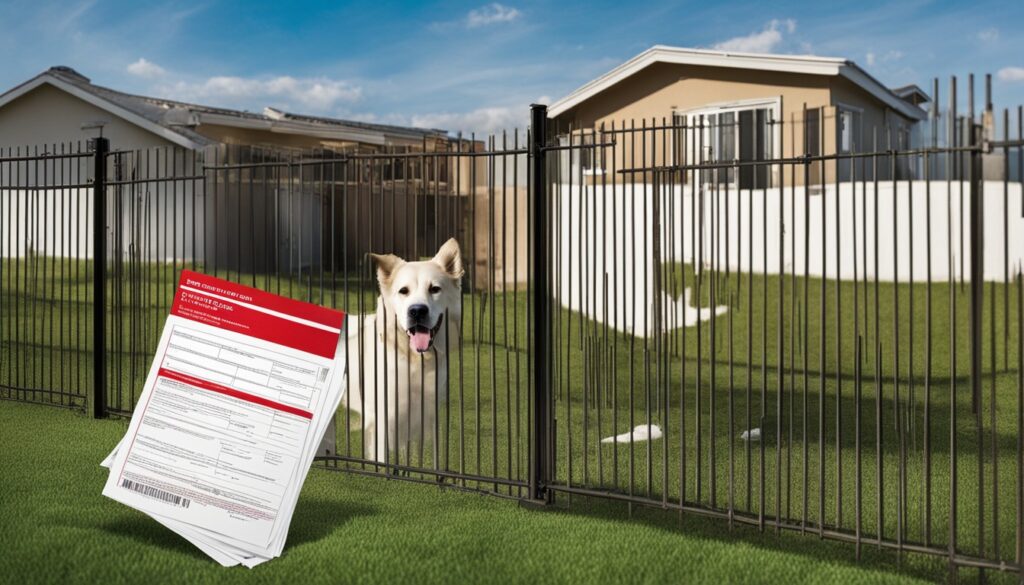
Choosing the Right Dog Breed for Your Family
Choosing the right dog breed is more than just finding a pet that fits your home and lifestyle. It’s also key to make sure you’re still covered financially if a dog-related claim happens. Think about the breed’s popularity, temperament, size, energy level, and how well it fits your household.
Factors to Consider Beyond Insurance
There are many things to think about when picking a dog, aside from insurance. These include:
- Temperament: Look into the breed’s typical personality traits. Check how they get along with kids, other pets, and strangers.
- Size and Activity Level: Make sure the dog’s size and energy needs match your family’s lifestyle and living space.
- Grooming Requirements: Think about the time and effort needed to keep the breed’s coat looking good.
- Training and Socialization: Consider how easy the breed is to train and how important early socialization is to prevent behavior problems.
By thinking about these factors, you can pick a dog breed that fits your home and avoids insurance issues later.
“Responsible dog ownership is key to ensuring a positive experience for both you and your canine companion.”
The right dog breed for your family meets your insurance needs and fits your lifestyle and home. With good research and planning, you can find a dog that will bring joy and companionship to your home for many years.
Responsible and Informed Dog Ownership
Bringing a dog into your home is a big step, filled with joy and big responsibilities. It’s not just about giving love and company. It means understanding the costs some breeds might bring. Training and socializing your dog can make your bond stronger and lower the chance of costly insurance claims.
Labrador retrievers have been the top dog breed in the U.S. for 30 years. 69% of U.S. households own a dog. But, some breeds like pit bulls, rottweilers, and German shepherds are more likely to be aggressive and bite. In 2020, insurance paid out over $853,700,000 from 16,991 dog bite claims, with an average payout of $50,000 per claim.
Insurance companies might charge more or not cover homes with these risky breeds. Owners of these dogs could end up paying for damages themselves. To avoid this, it’s key to train and socialize your dog well. This shows your dog is friendly and might get insurance coverage.
Responsible dog ownership means knowing the risks and the need for training and socialization. It also means understanding how your dog’s behavior affects insurance. Being informed and active helps keep your dog, family, and finances safe.
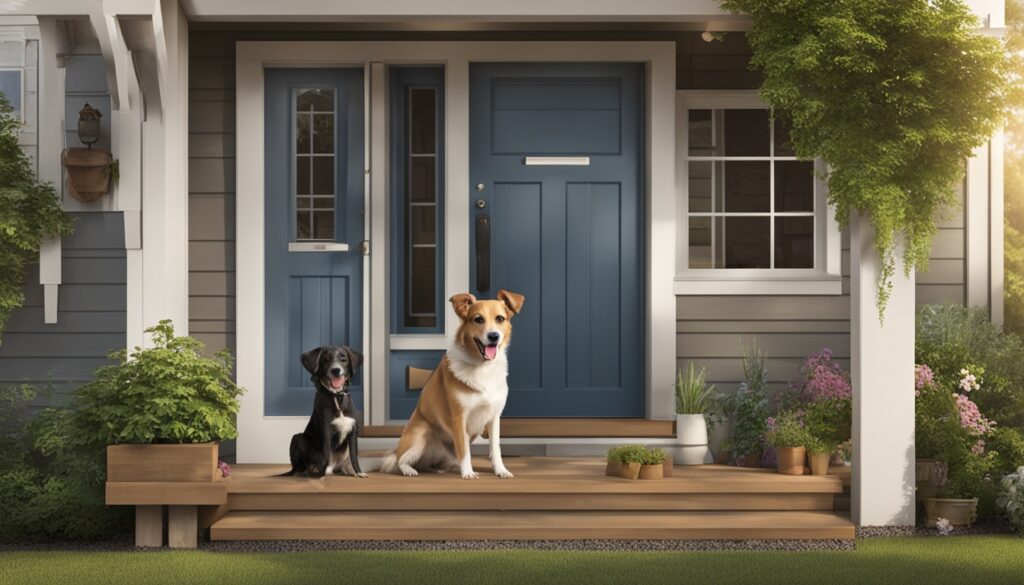
“Proper training and socialization of your pet can help mitigate aggressive behaviors and reduce the risk of incidents that could lead to costly insurance claims.”
what dog breeds affect homeowners insurance
Homeowners insurance companies look closely at some dog breeds. They see these breeds as more likely to cause incidents that lead to expensive claims. Pit Bulls, German Shepherds, Great Danes, Siberian Huskies, and Staffordshire Terriers are often restricted or excluded.
Insurance looks at a dog’s size, strength, and behavior to see if it’s a high-risk breed. Dogs known for being aggressive or having a history of attacks might face higher premiums or restrictions. But, some insurers might consider how well-trained a dog is to lower the risk.
In states like Pennsylvania, Michigan, Nevada, New York, and Connecticut, laws protect against breed discrimination in insurance. Yet, insurers can still deny coverage or raise rates for owners of high-risk breeds, even if they’re not on a list.
It’s important for pet owners to check their insurance policies and talk about their dog’s breed. They should look for other insurance options, like specialized providers or state FAIR plans, if they can’t get coverage elsewhere.
“Responsible pet ownership, proper training, and early socialization are key to preventing dog bite incidents and ensuring homeowners insurance coverage.”
Even though some dog breeds are seen as higher-risk, the American Veterinary Medical Association says how we behave and train our dogs matters a lot. By being responsible owners and taking steps to prevent incidents, we can make sure we get the insurance we need for our families and pets.
Insurance Companies with Restricted Breed Lists
Many home insurance companies have lists of dog breeds they won’t cover, known as “restricted breed lists.” These lists are often not shown to consumers. They are filed by insurers to state insurance departments. An analysis of 42 home insurance providers found that Pit Bulls, Rottweilers, Doberman Pinschers, Chow Chows, and Wolf Hybrids are most often banned from coverage.
Insurers say they restrict certain breeds because they are more likely to cause severe, costly incidents. The Insurance Information Institute says the average cost of a dog-related claim in 2022 was $64,555. So, home insurance providers might cancel or not renew policies for pet-related incidents like dog bites.
The Most Frequently Banned Breeds
- Pit Bulls
- Rottweilers
- Doberman Pinschers
- Chow Chows
- Wolf Hybrids
Other breeds like German Shepherds, Akitas, Staffordshire Terriers, and Alaskan Malamutes may also be excluded from coverage. Some insurers might even limit their coverage for dog or pet-related claims to less than the standard liability coverage limit.
“More than 17,000 dog bite claims are filed each year, making pet ownership a significant consideration for home insurance providers.”
Pet ownership is growing, making the impact of dog breeds on homeowners insurance policies more important for consumers to know. By understanding which breeds are often restricted, homeowners can make better choices when picking a pet. They can also ensure they have the right insurance coverage.

The Controversy Over Banned Dog Breeds
The controversy around insurance breed restrictions has sparked debate in the insurance world. Many home insurance companies list “restricted” dog breeds, citing concerns over the impact of breed discrimination in home insurance. But, dog lovers say this is unfair and hurts people who don’t know about it, especially those who are not white, and those who earn less.
Those against breed-specific insurance policies think insurers should look at the dog’s behavior, not just its breed. They say a dog’s behavior comes from how it was raised, trained, and where it lives, not just its genes.
“Breed-specific restrictions are a lazy way for insurers to manage risk. They ignore the complexities of dog behavior and unfairly penalize responsible owners and their pets.”
Not all home insurance companies have lists of banned dog breeds. Many decide on a case-by-case basis if they’ll cover a home with a risky dog. But, the debate over breed restrictions goes on, with strong arguments on both sides.
The controversy around insurance breed restrictions shows we need a smarter way to look at dog ownership risks. We should look at each household and dog’s unique traits, not just breed.
Dog Bite Insurance Claims and Statistics
In 2017, there were 18,522 dog bite liability insurance claims. This number went down to 16,991 in 2020. Yet, the average cost per claim stayed high at $50,245. These claims cost homeowners insurance providers almost $800 million a year.
Insurance companies worry about the number of serious injuries and deaths from dog bites, especially in children. The average dog bite claim costs around $44,760 as per the Insurance Information Institute. This leads insurers to not cover some dog breeds. This affects insurance rates and what pet owners can get.
“Liability claims related to dog bites cost homeowners insurers $1,116 million in 2023, with a total of 19,062 claims in the U.S., marking an 8.3% increase from the previous year.”
The number of dog bites and the severity of claims worry the insurance industry. Approximately 4.5 million people are bitten by dogs each year, with most of them being children. This shows the need for responsible dog ownership and understanding the risks of some breeds with insurance.

- In 2021, the Insurance Information Institute reported that dog bite claims cost insurance companies an average of $49,025 each.
- Some common dog breeds that insurers often do not cover due to aggressive tendencies or size include Akita, Alaskan malamute, Chow Chow, Doberman pinscher, German shepherd, Husky, Mastiff, Pit bull, Presa Canario, Rottweiler, and Wolf Hybrid.
- Pit bulls, Doberman Pinschers, and Rottweilers are the most frequently banned dog breeds by homeowners insurance companies, with 100% of the banned lists including these breeds.
The data on dog bite liability insurance claims and costs shows the importance of pet owners thinking about insurance when choosing a dog breed. Knowing the trends and statistics helps with making informed decisions and being a responsible dog owner.
Breed-Specific Legislation (BSL) and Its Impact
BSL is a type of law that targets certain dog breeds, banning or limiting them. Critics argue that this approach is flawed. They say it focuses on breed rather than the dog’s actions. Insurers often ban coverage for certain breeds, citing the risk of severe injuries.
BSL has sparked a heated debate. It affects dog owners and has led to more breed discrimination by insurance companies. This issue hits low-income and minority communities hard.
Major groups like veterinary organizations and breed registries oppose BSL. They say insurers use wrong data and bad assumptions. This has created a big problem for homeowners who can’t get insurance because of it.
“Breed discrimination in insurance is a recent phenomenon preceded by the enactment of breed-specific legislation in some states and municipalities.”
The 1980s saw a rise in BSL after a pit bull attack in New Mexico. This led to more bans on certain breeds. Now, BSL affects dog owners and the insurance industry.
- Claims associated with dog incidents cost insurers over $11.12 billion in 2023.
- The average cost per claim decreased from $64,555 in 2022 to $58,545 in 2023.
- Over 19,000 dog bite and related injury claims were reported in 2023, marking a 28% increase over 2021 and a 110% increase over the past decade.
- The average cost per claim rose by 32%.
- Currently, 73 municipalities across the United States have repealed their Breed-Specific Legislation (BSL) bans.
The insurance industry’s use of breed lists to deny coverage is a hot topic. BSL’s impact on dog owners is clear. Together, policymakers, insurers, and animal welfare groups must find a fair solution. This should support responsible pet ownership for everyone.
Insurance Companies Without Breed Restrictions
Homeowners often struggle to find insurance that covers their dogs, especially if they have breeds that are usually banned. But, there’s hope for those with restricted breeds. Some states now stop insurers from unfairly targeting certain dog breeds. This means more inclusive insurance options for pet owners.
If your state doesn’t stop insurers from banning breeds, you still have choices. Some insurance companies with inclusive pet policies don’t automatically block certain breeds. They believe that how well you train and care for your dog matters more than its breed.
Looking for homeowners insurance options for owners of restricted breeds means finding insurers known for not judging by breed. This can help pet owners who were once denied coverage. It’s a way to find insurance that fits your needs and protects your pets, no matter their breed.
“Responsible dog ownership and proper training are more reliable indicators of a pet’s behavior than breed alone.”
By checking out these insurance companies with inclusive pet policies, you can get coverage that suits you and your pets. A good insurance plan gives you peace of mind and keeps your pets safe, breed or not.

What dog breeds affect homeowners insurance
Homeowners insurance can be affected by the breed of your dog. Insurance companies often charge more or have rules for certain dog breeds. This is because some breeds are more likely to cause incidents.
The dog breeds most commonly restricted by home insurers include:
- Pit Bulls
- German Shepherds
- Great Danes
- Siberian Huskies
- Staffordshire Terriers
- Rottweilers
- Doberman Pinschers
- Chow Chows
- Wolf Hybrids
High-risk dog breeds are often seen as more aggressive. They are more likely to cause serious injuries if they attack. Because of this, insurance companies might not cover these breeds or charge more to cover them.
Homeowners insurance policies and specific dog breeds are closely related. If you have a dog breed that impacts home insurance coverage, finding affordable insurance can be hard. You might even be denied coverage.
“It is estimated that 4.7 million injuries occur from dog bites each year in the United States, with 800,000 requiring medical treatment.”
To make sure you have the right coverage for your dog, research what dog breeds affect homeowners insurance. Always tell your insurance company about your dog’s breed. Working with your insurer can help you understand dog breeds that impact home insurance coverage better. This way, you can get the protection you need.
How much does a dog add to home insurance
Bringing a dog into your home brings joy, but it also has financial implications. One often overlooked aspect is how dogs affect homeowners insurance premiums. Having a dog can significantly change the cost of your home insurance.
The main reason is the risk of dog bites. These can lead to high medical bills and court settlements. This can cause homeowners insurance premiums to go up if a claim is made. The Insurance Information Institute reports that the average cost for dog bite claims in 2021 was $49,025. If your insurance covers your dog and it bites someone, your premiums might increase.
Some dog breeds are seen as high-risk and can lead to higher insurance rates or even denial of coverage. Breeds like Pit Bulls, Rottweilers, German Shepherds, and American Bulldogs are often linked to aggressive behavior. This can mean increased home insurance costs for dog owners.
Other factors that can raise insurance costs include the dog’s size, biting history, and the number of claims. Homeowners should know that the average cost increase for homeowners insurance with a dog can vary a lot. This depends on these factors and the insurance company’s policies.
“Certain dog breeds known for being aggressive, such as Pit Bulls and Rottweilers, can increase homeowner’s insurance premiums.”
To lessen the impact of dogs on homeowners insurance premiums, pet owners might get an additional umbrella policy. This provides extra protection for pet-related claims. Some insurance companies also have fewer breeds excluded, offering coverage without breed discrimination.
In conclusion, having a dog can greatly affect your homeowners insurance premiums. Knowing what can increase costs and making smart insurance choices can help you manage this part of pet ownership.

Pet insurance cost
As a pet owner, understanding the cost of pet insurance is key. The price of pet insurance changes based on the dog’s age, breed, and coverage level. In 2022, the average monthly premium for accident and illness plans was $53.34 for dogs and $32.25 for cats.
For accident-only plans, the average monthly premium was $16.70 for dogs and $10.18 for cats. The yearly cost for dogs can go from $108 for accident-only to $456 for accident and illness plans. Adding routine care can increase the yearly cost by $168 to $391.
Cat insurance costs range from $72 yearly for accident-only to $276 for accident and illness plans. Routine care add-ons can add $168 to $391 yearly.
Several factors can change pet insurance premiums:
- The dog’s age (premiums are generally higher for older dogs)
- The dog’s breed (some breeds are considered higher risk and may have higher premiums)
- The level of coverage desired (more comprehensive plans will have higher premiums)
- The pet’s location (premiums may vary by state or region)
- The pet’s health history (pre-existing conditions may affect the premium)
To find the best and most affordable pet insurance, pet owners should compare quotes from different providers. Look at coverage levels, deductibles, and any exclusions or limitations. Understanding pet insurance costs helps pet owners make informed decisions and protect their pets.
“Protecting your pet with the right insurance plan can give you peace of mind and help you provide the best possible care for your furry friend.”
Dog bite insurance
Homeowners insurance often includes a crucial part called liability coverage. This coverage helps you financially if your dog bites someone, whether at your home or not. But, not all dogs are treated the same by insurance companies.
Some dogs, like pit bulls, German shepherds, and Rottweilers, are seen as high-risk. If your dog is one of these, your insurance might not cover a bite claim. It’s key to know what your policy says about your dog.
The average claim for dog bites in 2023 was about $58,500. Homeowners insurance usually covers dog bites with amounts between $100,000 to $500,000. For minor injuries, it covers from $1,000 to $5,000. But, some insurers won’t cover injuries from certain breeds.
Dog bite liability insurance and coverage for dog bite incidents can change a lot. This depends on your homeowners insurance policies and dog bite claims history. Knowing what your coverage includes and excludes is key to making good pet care choices and staying protected financially.
“The cost of the average dog-related claim has more than doubled since 2003, reaching over $64,000 in 2021.”
You might also think about getting a dog bite liability insurance policy on its own. This can help cover medical bills, legal fees, and more from a dog bite, even if your homeowners insurance doesn’t fully cover it.
Being a responsible pet owner means knowing about insurance and your dog’s breed. By checking your coverage, you can make sure you and your family are safe if your dog bites someone.

Pet insurance comparisons
Protecting your furry friends is crucial. Pet insurance helps a lot in this. With many providers and plans, comparing them is key to finding the right one for your pet and budget. Look at coverage levels, deductibles, annual limits, and breed-specific rules.
Looking at different pet insurance plans lets you see what each offers. Find a plan that covers accidents, illnesses, and regular check-ups. Some plans also cover boarding, alternative treatments, and help finding a lost pet.
It’s also important to check the company’s reputation, customer service, and how they handle claims. Reviews from other pet owners can be very helpful. Knowing the cost and any discounts, like for multiple pets or paying yearly, can help you save money.
When picking pet insurance, think about what’s most important for you and your pet. Looking at several options helps you make a smart choice. This way, you can make sure your pet gets the care they need.
Key Factors to Consider When Comparing Pet Insurance
- Coverage levels – See what medical care the plan covers, like accidents, illnesses, and check-ups.
- Deductibles and annual limits – Know the costs you’ll pay out-of-pocket and the plan’s maximum payouts.
- Breed-specific exclusions or restrictions – Check if the plan has any breed-based limits.
- Provider reputation and customer service – Look up reviews and ratings for a good experience.
- Premium costs and potential discounts – Check the monthly or yearly costs and any discounts you might get.
“Comparing pet insurance plans can be a game-changer in ensuring your furry friend receives the best possible care. Take the time to evaluate the options and find the coverage that truly meets your needs.”

Cat insurance cost uk
Cats often get left out when talking about pet insurance, but the cost of cat insurance in the UK is key for many owners. The price of cat insurance changes based on the cat’s age, breed, where you live, and how much coverage you want.
The cost of cat insurance is affected by the cat’s age. Young cats pay less, but older cats pay more because they’re more likely to get sick. Some cat breeds also face higher costs because they’re more prone to certain health problems.
Where you live also plays a role in the cost of insurance. Insurance companies might charge more in cities because vet care is pricier there. Owners in cities might pay more than those in the countryside.
- The cost of insurance also depends on what coverage you want. Plans with higher deductibles and lower payback rates are cheaper. But, plans with lower deductibles and higher payback rates cost more.
- When looking at insurance plans in the UK, think about the monthly cost and what’s covered. Check for any exclusions, limits, and extra benefits like wellness care or dental coverage.
Knowing what affects the cost of cat insurance in the UK helps owners make smart choices. By researching and comparing different options, you can find the best and most affordable plan for your cat. This way, your cat gets great care without breaking the bank.

“Proper pet care practices, including access to fresh water, preventative care, and awareness of regional hazards and weather conditions, can contribute to a pet’s well-being.”
Pet dental insurance
Keeping your pet’s teeth clean is key to their health. But, the costs for cleanings and other dental work can be high. Pet dental insurance can help cover these costs, making sure your pet gets the care they need.
Pet dental insurance plans cover many treatments. This includes periodontal disease, fractured teeth, gingivitis, gum disease, root canals, stomatitis, and teeth removal. For example, treating periodontal disease costs about $1,050 on average. So, insurance is a smart choice.
When looking at pet insurance, check the dental coverage. Some plans, like Embrace and Pets Best, cover periodontal disease for pets over 3 years after a cleaning. Others, like Trupanion and ASPCA Pet Health Insurance, offer more dental coverage in their accident and illness plans.
Buying pet dental insurance depends on how you handle unexpected vet bills. Dental treatments can cost from $200 to $3,000. Insurance can protect your wallet and give you peace of mind.
“Dental health is an often-overlooked aspect of overall pet wellness, but it’s crucial for their comfort and longevity. Pet dental insurance can be a lifesaver for pet owners facing the high costs of professional dental care.”
Whether you have a dog or a cat, pet dental insurance is a good idea. It keeps your pet’s teeth healthy and bright. Knowing the options and costs helps you make a choice that fits your pet and your budget.
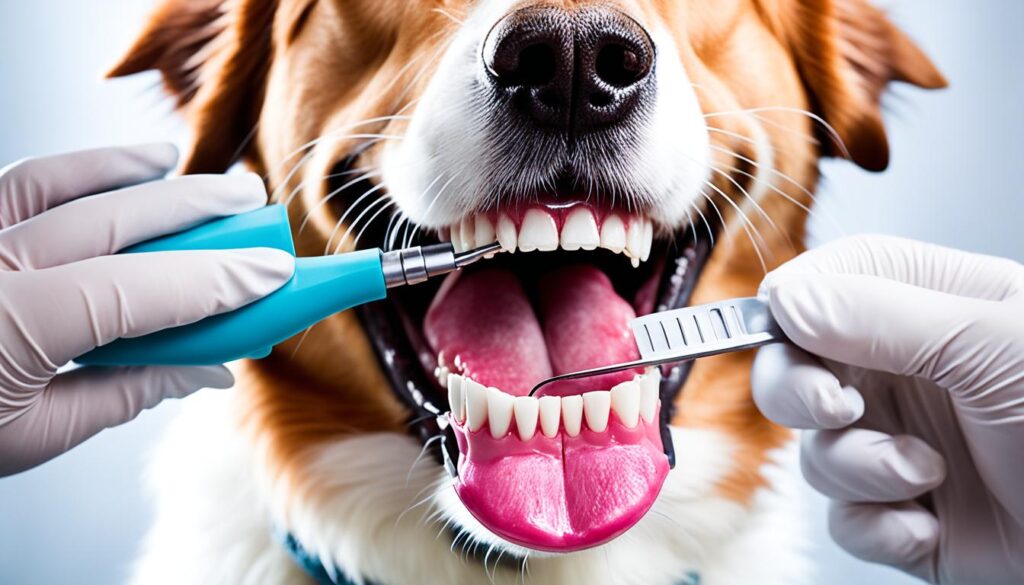
The cost of pet dental insurance changes based on the plan type, your pet’s age and breed, and coverage limits. Accident and illness insurance plans, which often include dental coverage, can cost $15 to $90 a month. Dogs usually cost more than cats.
In conclusion, pet dental insurance is a smart choice. It protects your pet’s teeth and can save you money on vet bills. By researching and understanding the options, you can make a choice that’s best for your pet’s health.
Dog walking insurance
For those running a dog walking or pet sitting business, the right insurance coverage is key. Dog walking insurance policies offer liability protection for accidents or incidents with the dogs. They cover medical bills, legal costs, and other expenses from dog-related issues. Pet owners should ask about the insurance coverage of the dog walking service they use.
Every year, more than 4.5 million people get bitten by dogs in the U.S. There’s been a 139% increase in dog bite claims and a 131% increase in the average cost per claim over the last decade. The average cost of dog bite claims went from $27,862 in 2013 to $64,555 in 2022. This shows why liability protection for dog walking businesses is vital.
Some dog breeds, like pit bulls, Doberman pinschers, German shepherds, Siberian huskies, and Staffordshire terriers, may have home insurance restrictions. But, dog walking insurance can offer extra coverage for professional pet service providers. This helps manage risks with dogs of different breeds and personalities.
- Dog walking insurance can cover medical bills, legal fees, and other costs from dog incidents.
- Umbrella policies with up to $5 million in liability coverage can give more protection to dog walking businesses.
- In states like New York, Texas, and Pennsylvania, pet liability insurance is needed for dogs seen as “vicious” or “dangerous”.
Getting the right insurance coverage for dog walking businesses is smart for professional dog walkers. It ensures they have the liability protection needed to work safely and responsibly. This protects their business and gives peace of mind to their clients and the pets they care for.
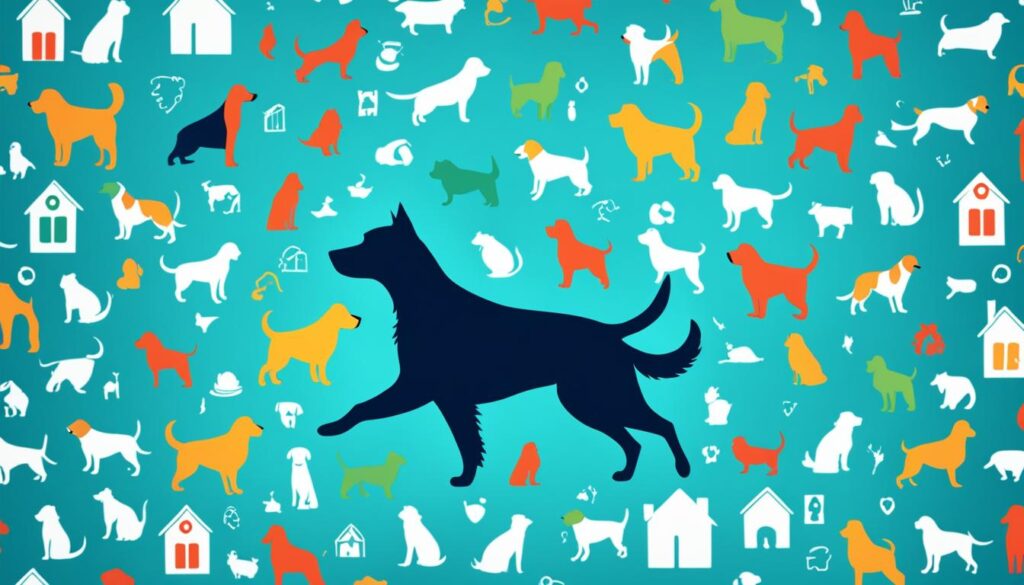
“Being a responsible and informed dog owner is key, as any dog can bite. Regular vet check-ups, socializing, and watching behavior can help prevent dog attacks.”
Pet insurance companies
Protecting your furry friends is important. Pet insurance companies offer many coverage options. Healthy Paws, Embrace, Petplan, and Nationwide are some top providers. They offer plans that cover unexpected vet bills, from routine visits to emergencies.
It’s key to compare pet insurance plans. Look at coverage limits, deductibles, and how much you’ll get back on claims. Check for breed-specific rules too. This way, you can pick the best plan for your pets.
Healthy Paws has no per-incident caps and unlimited coverage each year. Embrace has a decreasing deductible and a wellness rewards program. Petplan covers accidents and illnesses well, and Nationwide lets you choose your vet.
Choosing the right pet insurance depends on what you need and like. By looking at different plans, you can pick the best one for your pet. This ensures your furry friends get the best care.
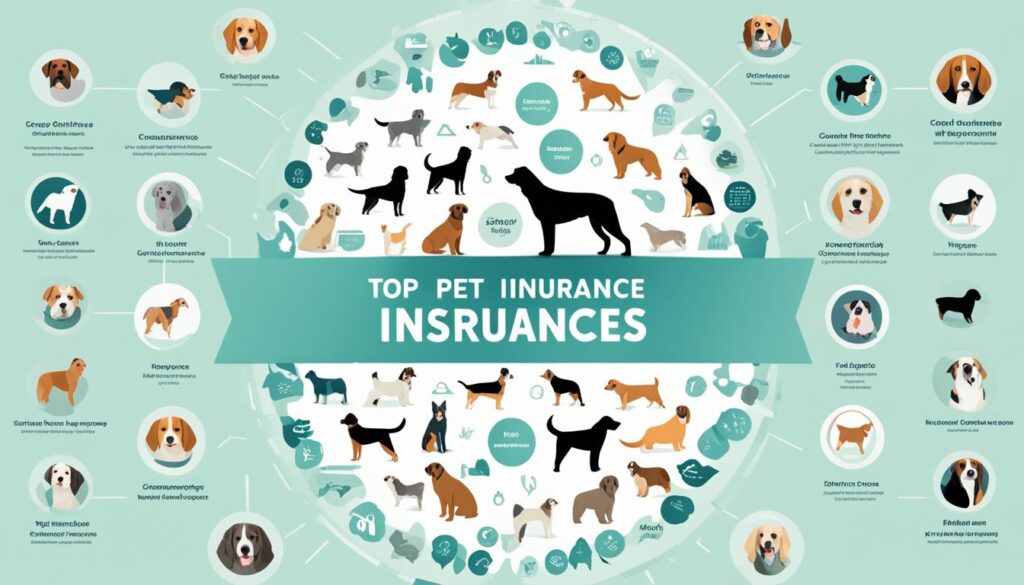
“Choosing the right pet insurance plan can make a significant difference in providing the best possible care for our beloved pets.”
- Consider coverage limits, deductibles, and reimbursement rates when comparing pet insurance plans.
- Look for companies that offer breed-specific coverage and do not have restrictive exclusions.
- Evaluate the customer service and claims processing efficiency of the pet insurance providers.
- Compare the monthly premiums and any additional fees associated with the pet insurance plans.
- Ensure the pet insurance policy aligns with your pet’s age, health, and any pre-existing conditions.
By looking at what different pet insurance companies offer, you can find the best coverage for your pets.
Pet liability insurance for renters
Renting a home means you need to think about insurance, especially for pets. It’s key to know how your insurance can help if your pet hurts someone. Renters insurance often covers pet liability, helping with costs from dog bites or other pet incidents.
Most renters insurance policies cover pets, but some dogs might not be covered. Dogs like pit bulls, Rottweilers, and German shepherds are seen as higher risk. They might not get coverage or could pay more for it. Always check your policy and talk to your insurer about breed restrictions or extra costs.
Renters insurance is a big help for pet owners, covering liability up to policy limits. But remember, it doesn’t cover damage to your own stuff or property. You might need extra pet insurance or pick a rental that fits your pet’s needs. Knowing about pet liability coverage helps renters stay protected in case of an accident.

